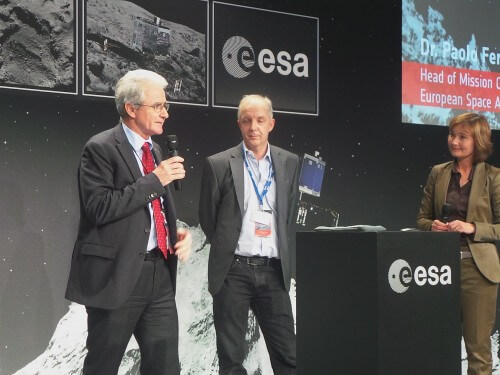This is how the landing manager at the European Space Agency, Stefan Olmak, explains at a press conference at the end of the long day in which I accompanied, together with hundreds of other journalists, the preparations for the landing, and the somewhat problematic landing of Philae on the comet 67P Churyumov Garsimenko

Landing Director Stephan Olmec and European Space Agency Operations Director Paolo Perry participated this evening in a press conference that was postponed several times, to tell about the situation of the Philae lander on the nucleus of the comet 67P Churyumov Garsimenko, about seven hours after it was launched from the Rosetta spacecraft to which it was attached for over from a decade
Olmec first explained that landing on the nucleus of a comet is a complicated matter. "It's hard to explain because we still don't know for sure what happened during the landing. According to the signals we received the spaceship has landed. We also received first data from the lander - both maintenance data and scientific data. What we know is that the anchors were not caught, meaning they are not anchored to the ground."
"Now we are trying to assess the situation. If Philae landed in a soft "sandbox" everything is fine. We checked the data, it's interesting but we don't fully understand what happened there. We do have some ideas though. We have fluctuations in the radio transmission, the transmission always resumes after a slight disconnection. The various cameras on the lander transmitted the first images and the scientists will process them and publish them later."
"Some of these data indicate that the lander probably landed and then took off again, slowly because the landing was planned so that most of the energy from the impact with the ground was absorbed. In the first two hours we experienced fluctuations not only in the radio transmission but also in the energy production from the solar collectors. Which can be interpreted as landing and launching. After two hours, the disruption in energy production stopped, and we were left with only the malfunctions in the radio transmission, so it is possible that we landed not once, but twice tonight."
"We currently have no contact with the lander, because Rosetta has sunk below the horizon from its vantage point. During the night we will only activate the CONSERT device. In the morning when the connection is restored we will download the data that the device will collect during the disconnection period. Then we will also know what happened to Philae, at the most it is in a different location than where it landed and to continue the scientific activity. As mentioned, at the moment these are speculations".
Paolo Perry: "People from all three centers are meant together to try to decipher all the signs to understand what happened. Our data was that the lander landed very close to the center of the error ellipse for the first time. We lost radio contact earlier than expected, but Rosetta sank below the horizon and if there is a horizon with mountains and hills, it could sink earlier. "
"From our side, the work has been done, and we are examining the data." Perry concluded.
The CEO of the European Space Agency, Jean-Jacques Derdin said that despite the failures, this was a very successful operation, and added with a smile, "I am happy to announce that PHILAE landed on the right comet."
Latest articles

6 תגובות
excuses …
Sounds like a small crush.